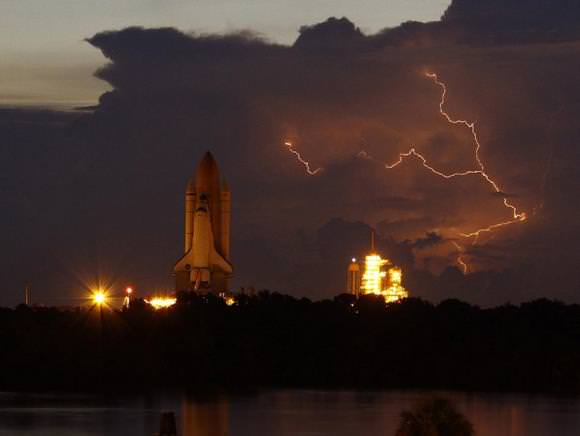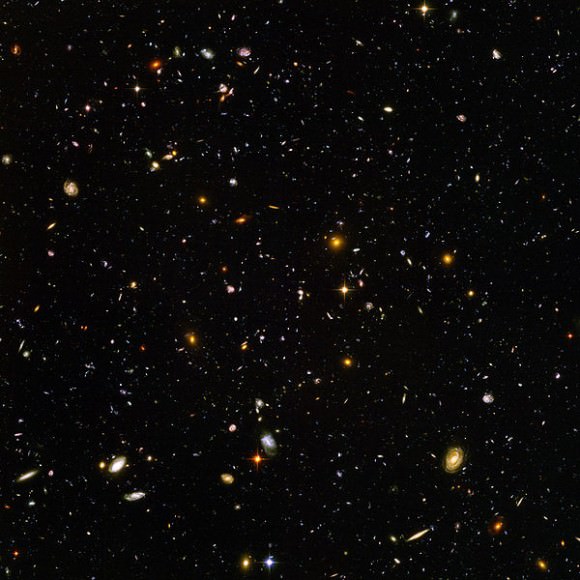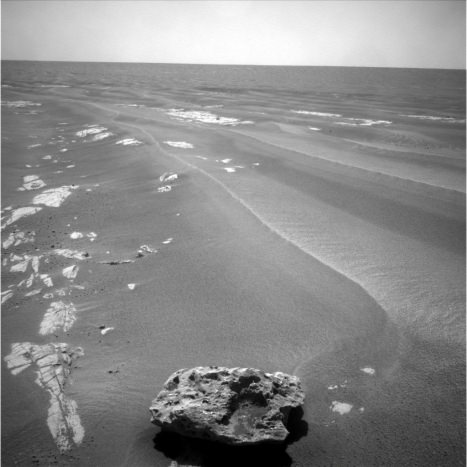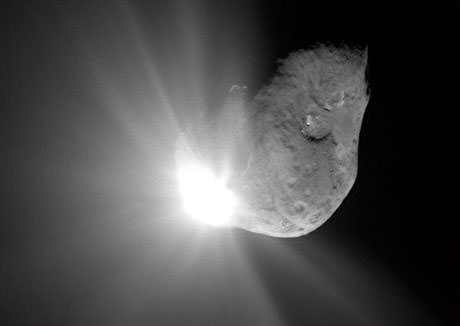IYA Live Telescope Today: M11 and 47 Tucanae
![]() Did you get a chance to check out the IYA "Live" Telescope today? After a prolonged period of clouds and bad weather in Central Victoria, we at least had a partially clear night. Our two objects for the evening were Messier 11 and stunning globular cluster 47 Tucanae. If you didn't get a chance to see them, why not step inside? We're making popcorn and playing a re-run… (...)
Did you get a chance to check out the IYA "Live" Telescope today? After a prolonged period of clouds and bad weather in Central Victoria, we at least had a partially clear night. Our two objects for the evening were Messier 11 and stunning globular cluster 47 Tucanae. If you didn't get a chance to see them, why not step inside? We're making popcorn and playing a re-run… (...)
Read the rest of IYA Live Telescope Today: M11 and 47 Tucanae (346 words)
Titan Shaping Up to Look a Lot Like Pre-Life Earth
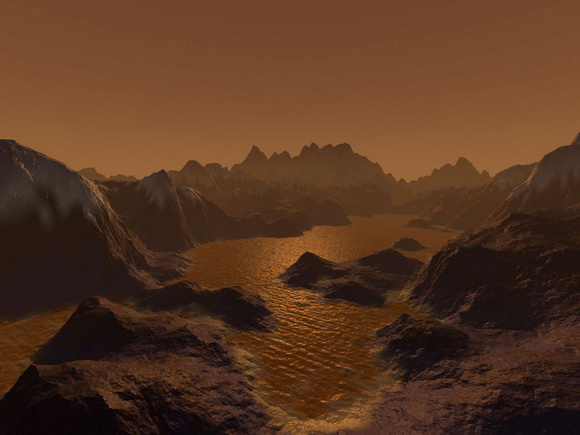
It's more than a billion kilometers (759 million miles) away, but the more astronomers learn about Titan, the more it looks like Earth.
That's the theme of two talks happening this week at the International Astronomical Union meeting in Rio de Janeiro, Brazil. Two NASA researchers, Rosaly Lopes and Robert M. Nelson of the Jet Propulsion Laboratory in Pasadena, California, are reporting that weather and geology have very similar actions on Earth and Titan — even though Saturn's moon is, on average, 100 degrees C (212 degrees F) colder than Antarctica (and certainly much more frigid than either California or Brazil; lucky astronomers).
The researchers are also reporting a tantalizing clue in the search for life: Titan hosts chemistry much like pre-biotic conditions on Earth.
(...)
Read the rest of Titan Shaping Up to Look a Lot Like Pre-Life Earth (567 words)
Ares I-X Comes Together (and it is BIG)
The Ares I-X rocket is being stacked on the Mobile Launch Platform in NASA's Vehicle Assembly Building in preparation for the rocket's first test flight, scheduled for October 31, 2009. The "super stack 1" was mated to the forward motor segment, and the rocket — which will stand at 99 meters (327 feet) — is now more than half way assembled. Assembly is done using a massive overhead crane, specially adapted for I-X use.
For comparison, the space shuttle stands at 56.1 m (184 ft), the Saturn V rocket was 110.6 m (363 ft), and the Ares V will be 116 m (380 ft) high.
See more images of the rocket below.
(...)
Read the rest of Ares I-X Comes Together (and it is BIG) (242 words)
New View Toward Carina Reveals Star Fest, Exploding "Engine"
 A remarkable new view of the Milky Way toward the constellation Carina is alive with a flurry of stars — and the pièce de résistance is a binary star that's all dressed up in a nebula of its own making.
A remarkable new view of the Milky Way toward the constellation Carina is alive with a flurry of stars — and the pièce de résistance is a binary star that's all dressed up in a nebula of its own making.
The European Southern Observatory (ESO) released the new images this week.
(...)
Read the rest of New View Toward Carina Reveals Star Fest, Exploding "Engine" (413 words)
There Was a Reason Discovery's Rollout Took Longer Than Usual…
Yikes! No wonder the rollout of space shuttle Discovery took a little bit longer than usual. Lightning lit up the sky above Kennedy Space Center early Tuesday morning, providing a stunning backdrop for the shuttle's crawl to the launchpad. Usually the trip takes about six hours, but various weather-related concerns slowed the move out past 11 hours. Lightning delayed Discovery's exit from the Vehicle Assembly Building for about 2 hours, and then mud from recent thunderstorms forced the crawler to stop repeatedly so engineers could clean out the giant treads on the huge 5.5 million-pound (2.4 million-kg) vehicle that hauls shuttles out to the launch pad. Discovery is scheduled to launch on August 25 for the STS-128 mission to the ISS. Of interest is that this mission will bring the C.O.L.B.E.R.T treadmill to the station, an exercise device named after comedian Stephen Colbert.
(...)
Read the rest of There Was a Reason Discovery's Rollout Took Longer Than Usual… (65 words)
Hubble, Gemini Spot 'Hyperactive' Stars in Small, Young Galaxies

We all know youngsters are a handful, but this really takes the cake: astronomers have clocked the speeds of stars in infant galaxies at about a million miles an hour, about twice the pace of our Sun's cruise through the Milky Way.
The small galaxies date to 11 billion years ago, when the universe was just a couple billion years old. Their stars, astronomers say, are buzzing and whirling at head-spinning rates.
(...)
Read the rest of Hubble, Gemini Spot 'Hyperactive' Stars in Small, Young Galaxies (354 words)
Half Comet-Half Asteroid a Fluke? Nope

Back in 1996, astronomers discovered a strange object in the asteroid belt. They decided it was either a "lost" comet or an icy asteroid, as it ejected dust like a comet but had an orbit like an asteroid. No one had ever seen anything like the object, called 133P. Ever since it was found, astronomers have wondered if it was just an oddity — one of a kind. We now know it is not, and the discovery of more of these half asteroids/half comets means there is a new class of objects in our solar system.
(...)
Read the rest of Half Comet-Half Asteroid a Fluke? Nope (312 words)
LCROSS Sees Life on Earth
The LCROSS spacecraft took a look back at Earth, and guess what it saw? Evidence of intelligence? Not so much. But it did see evidence of life. On Aug. 1, 2009, the LCROSS spacecraft took a gander at Earth to help calibrate and test its science payload. During the Earth observations, the spacecraft's spectrometers were able to detect the signatures of the Earth's water, ozone, methane, oxygen, carbon dioxide and possibly vegetation.
(...)
Read the rest of LCROSS Sees Life on Earth (281 words)
Plains of Titan to be Named for "Dune" Novels

Titan's mysterious dark plains will be named after planets in the series of "Dune" science fiction novels by author Frank Herbert. The US Geological Survey Astrogeology Science Center announced the first plain or "planitia" given a name will be designated as Chusuk Planitia. Chusuk was a planet from the Dune series, known for its musical instruments. Chusuk Planitia is located at 5.0S, 23.5W, and in the picture here is the small, dark area next to the "C" of Chusuk.
(...)
Read the rest of Plains of Titan to be Named for "Dune" Novels (305 words)
Astro Art of the Week: Dragon Vs. Eagle
Here's the fourth installment of our new feature, showcasing our readers' prowess with image editing software. This week's Astro Art of the Week is a showdown of cosmic proportions: "Dragon Versus Eagle" was submitted by Wienie van der Oord from Negev Desert in Israel.
The image of the Eagle Nebula was taken by Wienie's friend, Kfir Simon, with a DSI 3 pro, HAlpha filter and a Canon with 200mm lens. You can see more of Kfir's astrophotography here. . Thanks Wienie and Kfir!
Also, we're still contemplating a good title for this feature. We've tried "Astro 'Shop of the Week," (as in 'Photoshop') and now "Astro Art of the Week." If you have any suggestions for a good title, post it in the comment section. Thanks!
How Many Galaxies Have We Discovered?
Astronomers think that there are hundreds of billions galaxies in the universe, however the exact number is not known. But astronomers should know how many galaxies we've actually seen and discovered, right? Well, not necessarily. “We don’t know,” says Ed Churchwell, professor of astronomy at the University of Wisconsin-Madison. “We know it’s a very large number.” In just one image for example, the Hubble Ultra Deep Field, above, there are about 10,000 galaxies visible.
(...)
Read the rest of How Many Galaxies Have We Discovered? (313 words)
Opportunity Spies Unusual Rock — Large Meteorite?
The Opportunity rover has come across an odd-shaped, large, dark rock, about 0.6 meters (2 feet) across on the surface of Mars, which may be a meteorite. The rover team spotted the rock called "Block Island," on July 18, 2009, in the opposite direction from which it was driving. The team then had the rover do a hard right (not really, but you know what I mean) and backtrack some 250 meters (820 feet) to study it closer. Oppy has been studying the rock with its alpha particle X-ray spectrometer to get composition measurements and to confirm if indeed it is a meteorite.
Below, see a close-up, colorized version of Block Island and a 3-D version, both created by Photoshopper Extraordinaire Stu Atkinson.
(...)
Read the rest of Opportunity Spies Unusual Rock — Large Meteorite? (151 words)
Top Five Celestial Objects Anyone Can See With a Small Telescope
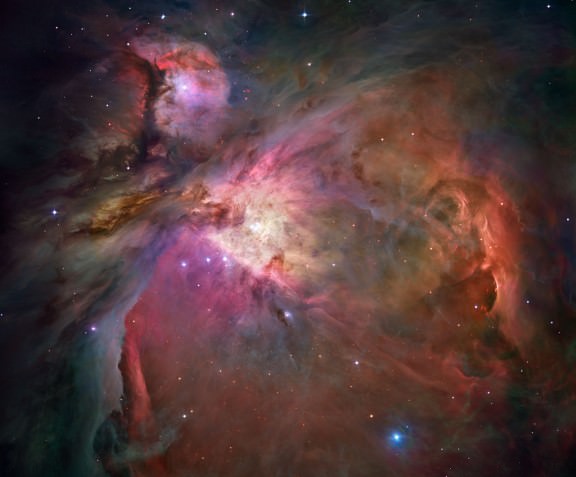
Popular Mechanics has a great series of articles today on amateur astronomy, including Affordable Ways to Become an Amateur Astronomer, and How to Computerize Your Telescope. But my favorite is the Top Five Galactic Bodies Anyone Can See With a Cheap Telescope. Number one on the list is the Orion Nebula, above. Granted, with small telescopes, it won't look like this Hubble Space Telescope image, but The Great Nebula is even visible with the naked eye in the northern hemisphere, and looks pretty impressive in small telescope, too. To find it, those in the northern hemisphere will have to wait until cooler weather approaches. But look for Orion's belt, three bright stars in a row. Hanging south from the belt is Orion's sword, composed of three bright dots; the center dot is the great nebula.
(...)
Read the rest of Top Five Celestial Objects Anyone Can See With a Small Telescope (335 words)
Sub-surface Oceans In Early Comets Suggest Possible Origin of Li
A new study claims early comets contained vast interior oceans of liquid water that may have provided the ideal conditions for early life to form.
(...)
Read the rest of Sub-surface Oceans In Early Comets Suggest Possible Origin of Life (299 words)
Galaxies Bring Dancing With the Stars to New Level

What is small, mysterious, faint, in the process of losing mass, and can dance like crazy? Could it be Marie Osmond? Well, that might be the correct answer in this galaxy, but just on the outskirts of the Milky Way are small, mysterious galaxies called dwarf spheroidal galaxies, and a new study offers an explanation for the origin of these puzzling objects. But can they really dance? Yes, says lead author Elena D'Onghia of the Harvard-Smithsonian Center for Astrophysics.
(...)
Read the rest of Galaxies Bring Dancing With the Stars to New Level (343 words)

